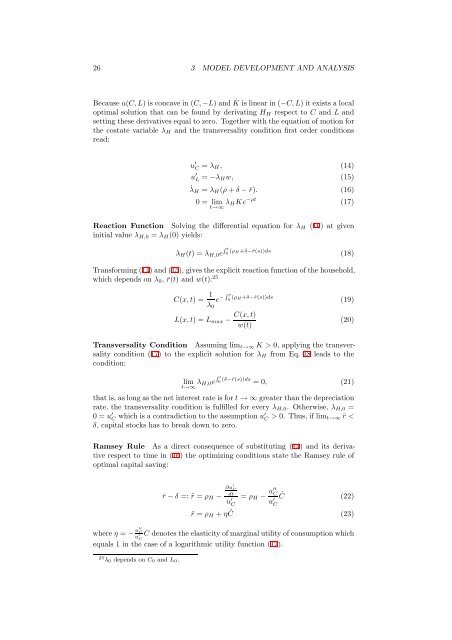Modeling Climate Policy Instruments in a Stackelberg Game with ...
Modeling Climate Policy Instruments in a Stackelberg Game with ...
Modeling Climate Policy Instruments in a Stackelberg Game with ...
You also want an ePaper? Increase the reach of your titles
YUMPU automatically turns print PDFs into web optimized ePapers that Google loves.
26 3 MODEL DEVELOPMENT AND ANALYSIS<br />
Because u(C, L) is concave <strong>in</strong> (C, −L) and ˙K is l<strong>in</strong>ear <strong>in</strong> (−C, L) it exists a local<br />
optimal solution that can be found by derivat<strong>in</strong>g H H respect to C and L and<br />
sett<strong>in</strong>g these derivatives equal to zero. Together <strong>with</strong> the equation of motion for<br />
the costate variable λ H and the transversality condition first order conditions<br />
read:<br />
u ′ C = λ H, (14)<br />
u ′ L = −λ H w, (15)<br />
˙λ H = λ H (ρ + δ − ¯r). (16)<br />
0 = lim<br />
t→∞<br />
λ H Ke −ρt (17)<br />
Reaction Function Solv<strong>in</strong>g the differential equation for λ H (16) at given<br />
<strong>in</strong>itial value λ H,0 = λ H (0) yields:<br />
λ H (t) = λ H,0 e R t<br />
0 (ρH+δ−¯r(s))ds (18)<br />
Transform<strong>in</strong>g (14) and (15), gives the explicit reaction function of the household,<br />
which depends on λ 0 , ¯r(t) and w(t): 25<br />
C(x, t) = 1 λ 0<br />
e − R t<br />
0 (ρH+δ−¯r(s))ds (19)<br />
L(x, t) = L max −<br />
C(x, t)<br />
w(t)<br />
(20)<br />
Transversality Condition Assum<strong>in</strong>g lim t→∞ K > 0, apply<strong>in</strong>g the transversality<br />
condition (17) to the explicit solution for λ H from Eq. 18 leads to the<br />
condition:<br />
lim λ H,0e R t<br />
0 (δ−¯r(s))ds = 0, (21)<br />
t→∞<br />
that is, as long as the net <strong>in</strong>terest rate is for t → ∞ greater than the depreciation<br />
rate, the transversality condition is fulfilled for every λ H,0 . Otherwise, λ H,0 =<br />
0 = u ′ C which is a contradiction to the assumption u′ C > 0. Thus, if lim t→∞ ¯r <<br />
δ, capital stocks has to break down to zero.<br />
Ramsey Rule As a direct consequence of substitut<strong>in</strong>g (14) and its derivative<br />
respect to time <strong>in</strong> (16) the optimiz<strong>in</strong>g conditions state the Ramsey rule of<br />
optimal capital sav<strong>in</strong>g:<br />
¯r − δ =: ˜r = ρ H −<br />
∂u ′ C<br />
dt<br />
u ′ C<br />
= ρ H − u′′ C<br />
u ′ Ċ (22)<br />
C<br />
˜r = ρ H + ηĈ (23)<br />
where η = − u′′ C<br />
u ′<br />
C<br />
C denotes the elasticity of marg<strong>in</strong>al utility of consumption which<br />
equals 1 <strong>in</strong> the case of a logarithmic utility function (12).<br />
25 λ 0 depends on C 0 and L 0 .
















